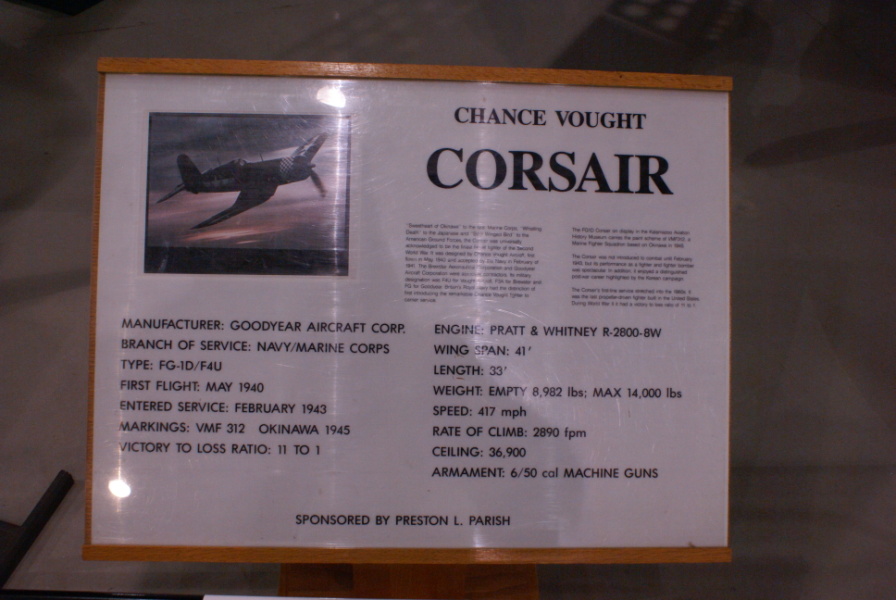| Prev |
heroicrelics.org Air Zoo Site Index Corsair (East Campus) Gallery |
Next |
dsc70668.jpg
The sign which accompanied the Corsair. It reads
Chance Vought
Corsair
"Sweetheart of Okinawa" to the U.S. Marine Corps. "Whistling Death" to the Japanese and "Bent Winged Bird" to the American Ground Forces, the Corsair was universally acknowledged to be the finest Naval fighter of the Second World War. It was designed by Chance Vought Aircraft, first flown in May 1940 and accepted by the Navy in February of 1941. The Brewster Aeronautical Corporation and Goodyear Aircraft Corporation were associate contractors. Its military designation was F4U for Vought Aircraft, F3A for Brewster and FG for Goodyear. Britain's Royal Navy had the distinction of first introducing the remarkable Chance Vought fighter to carrier service.
The FG1D Corsair on display in the Kalamazoo Aviation History Museum carries the paint scheme of VMF312, a Marine Fighter Squadron based on Okinawa in 1945.
The Corsair was not introduced to combat until February 1943, but its performance as a fighter and fighter bomber was spectacular. In addition, it enjoyed a distinguished post-war career highlighted by the Korean campaign.
The Corsair's first-line service stretched into the 1920. It was the last propeller-driven fighter built in the United States. During World War II it had a victory to loss ratio of 11 to 1.
Manufacturer: Goodyear Aircraft Corp. Engine: Pratt & Whitney R-2800-8W Branch of Service: Navy/Marine Corps Wing Span: 41' Type: FG-1D/F4U Length: 33' First Flight: May 1940 Weight: Empty 8,982 lbs; Max 14,000 lbs Entered Service: February 1943 Speed: 417 mph Markings: VMF 312 Okinawa 1945 Rate of Climb: 2890 fpm Victory to Loss Ratio: 11 to 1 Ceiling: 36,900 Armament: 6/50 cal machine guns Sponsored by Preston L. Parish

| Time picture taken | Thu Oct 29 14:30:06 2009 |
| Location picture taken | Naval Aviation Hangar East Campus Air Zoo Portage, MI |
| Prev | Corsair (East Campus) Gallery | Next |